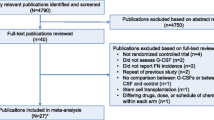Abstract
Background
In order to analyze the clinical activity and cost-effectiveness of granulocyte colony-stimulating factors (G-CSF), the prophylactic usage of G-CSF in patients treated with a single chemotherapy regimen during early courses was prospectively evaluated.
Methods
Thirty patients with newly diagnosed non-Hodgkin lymphoma (NHL) treated with the first course of an R-CHOP regimen were enrolled randomly. After treatment with the first course of chemotherapy, a daily dose of G-CSF (lenograstim, 100 μg) was administered to half (15 cases) of the patients, and a dose of G-CSF (100 μg) was administered every other day to the other half of the patients when leukocytopenia (<1.5 × 109/L) and/or neutropenia (<0.5 × 109/L) occurred. Changes in leukocyte and neutrophil counts, prophylaxis, febrile neutropenia (FN) events, and cost performance between the two groups were analyzed.
Results
No significant difference between the two groups was observed in recoveries of leukocyte and neutrophil counts and evidence of FN. The only difference was the total cost of G-CSF.
Conclusion
We concluded that every-other-day use of G-CSF was as clinically effective for the prophylaxis of FN as the daily use of G-CSF, and economically speaking, the administration of G-CSF every other day should be more beneficial for patients with NHL during early courses of R-CHOP chemotherapy.

Similar content being viewed by others
References
Lieschke GJ, Burgess AW (1992) Granulocyte colony-stimulating factor and granulocyte-macrophage colony-stimulating factor (1). N Eng J Med 327:28–35
Roilides E, Walsh TJ, Pizzo PA et al (1991) Granulocyte colony-stimulating factor enhances the phagocytic and bactericidal activity of normal and defective human neutrophils. J Infect Dis 163:579–583
Erbe DV, Collins JE, Shen L et al (1990) The effect of cytokines on the expression and function of Fc receptors for IgG on human myeloid cells. Mol Immunol 27:57–60
Carulli G (1997) Effects of recombinant human granulocyte colony-stimulating factor administration on neutrophil phenotype and functions. Haematologica 82:606–616
Rouveix B, Giroud JP, Levacher M (2001) G-CSF: mode of action and antiinfective activities. Antibiotiques 3:83–89
Smith TJ, Khatcheressian J, Lyman GH et al (2006) 2006 update of recommendation for the use of white blood cell growth factors: an evidence-based clinical practice guideline. J Clin Oncol 24:3187–3205
Pettengell R, Aapro M, Brusamolino E et al (2009) Implications of the European Organisation for Research and Treatment of Cancer (EORTC) guidelines on the use of granulocyte colony-stimulating factor (G-CSF) for lymphoma care. Clin Drug Invest 29:491–513
Watts MJ, Addison I, Long SG et al (1997) Crossover study of the haematological effects and pharmacokinetics of glycosylated and non-glycosylated G-CSF in healthy volunteers. Br J Haematol 98:474–479
Dunn CJ, Goa KL (2000) Lenograstim: an update of its pharmacological properties and use in chemotherapy-induced neutropenia and related clinical settings. Drugs 59:681–717
Kim IH, Park SK, Suh OK et al (2003) Comparison of lenograstim and filgrastim on haematological effects after autologous peripheral blood stem cell transplantation with high-dose chemotherapy. Curr Med Res Opinion 19:753–759
Ataergin S, Arpaci F, Turan M et al (2008) Reduced dose of lenograstim is as efficacious as standard dose of filgrastim for peripheral blood stem cell mobilization and transplantation: a randomized study in patients undergoing autologous peripheral stem cell transplantation. Am J Hematol 83:644–648
Welte K, Gabrilove J, Bronchud MH et al (1996) Filgrastim (r-metHuG-CSF): the first 10 years. Blood 15:1907–1929
Kerst JM, de Haas M, van der Schoot CE et al (1993) Recombinant granulocyte colony-stimulating factor administration to healthy volunteers: induction of immunophenotypically and functionally altered neutrophils via an effect on myeloid progenitor cells. Blood 82:3265–3272
Balducci L, Al-Halawani H, Charu V et al (2007) Elderly cancer patients receiving chemotherapy benefit from first-cycle pegfilgrastim. Oncologist 12:1416–1424
Crawford J, Dale DC, Kuderer NM et al (2008) Risk and timing of neutropenic events in adult cancer patients receiving chemotherapy: the results of a prospective nationwide study of oncology practice. JNCCN 6:109–118
Lyman GH (2009) Impact of chemotherapy dose intensity on cancer patient outcomes. JNCCN 7:99–108
Lyman GH, Dale DC, Friedberg J et al (2004) Incidence and predictors of low chemotherapy dose-intensity in aggressive non-Hodgkin’s lymphoma: a nationwide study. J Clin Oncol 22:4302–4311
Holmes A, O’Shaughnessy JA, Vukelja S et al (2002) Blinded, randomized, multicenter study to evaluate single administration pegfilgrastim once per cycle versus daily filgrastim as an adjunct to chemotherapy in patients with high-risk stage II or stage III/IV breast cancer. J Clin Oncol 20:727–731
Green MD, Koelbl H, Baselga J et al (2003) A randomized doubleblind multicenter phase III study of fixed-dose single administration pegfilgrastim versus daily filgrastim in patients receiving myelosuppressive chemotherapy. Ann Oncol 14:29–35
Pinto L, Liu Z, Doan Q et al (2007) Comparison of pegfilgrastim with filgrastim on febrile neutropenia, grade IV neutropenia and bone pain: a meta-analysis of randomized controlled trials. Curr Med Res Opin 23:2283–2295
Siena S, Piccart MJ, Holmes FA et al (2003) A combined analysis of two pivotal randomized trials of a single dose of pegfilgrastim per chemotherapy cycle and daily filgrastim in patients with stage II–IV breast cancer. Oncol Rep 10:715–724
Lyman GH, Lalla A, Barron RL et al (2009) Cost-effectiveness of pegfilgrastim versus filgrastim primary prophylaxis in women with early-stage breast cancer receiving chemotherapy in the United States. Clin Ther 31:1092–1104
Acknowledgments
The registration number of this trail is 16–23 (approved on June 26, 2004 by the Local Ethical Committee of Clinical Study at Ehime University Graduate School of Medicine).
Conflict of interest
The authors indicated no potential conflicts of interest.
Author information
Authors and Affiliations
Corresponding author
About this article
Cite this article
Yakushijin, Y., Shikata, H., Takaoka, I. et al. Usage of granulocyte colony-stimulating factor every 2 days is clinically useful and cost-effective for febrile neutropenia during early courses of chemotherapy. Int J Clin Oncol 16, 118–124 (2011). https://doi.org/10.1007/s10147-010-0134-x
Received:
Accepted:
Published:
Issue Date:
DOI: https://doi.org/10.1007/s10147-010-0134-x




